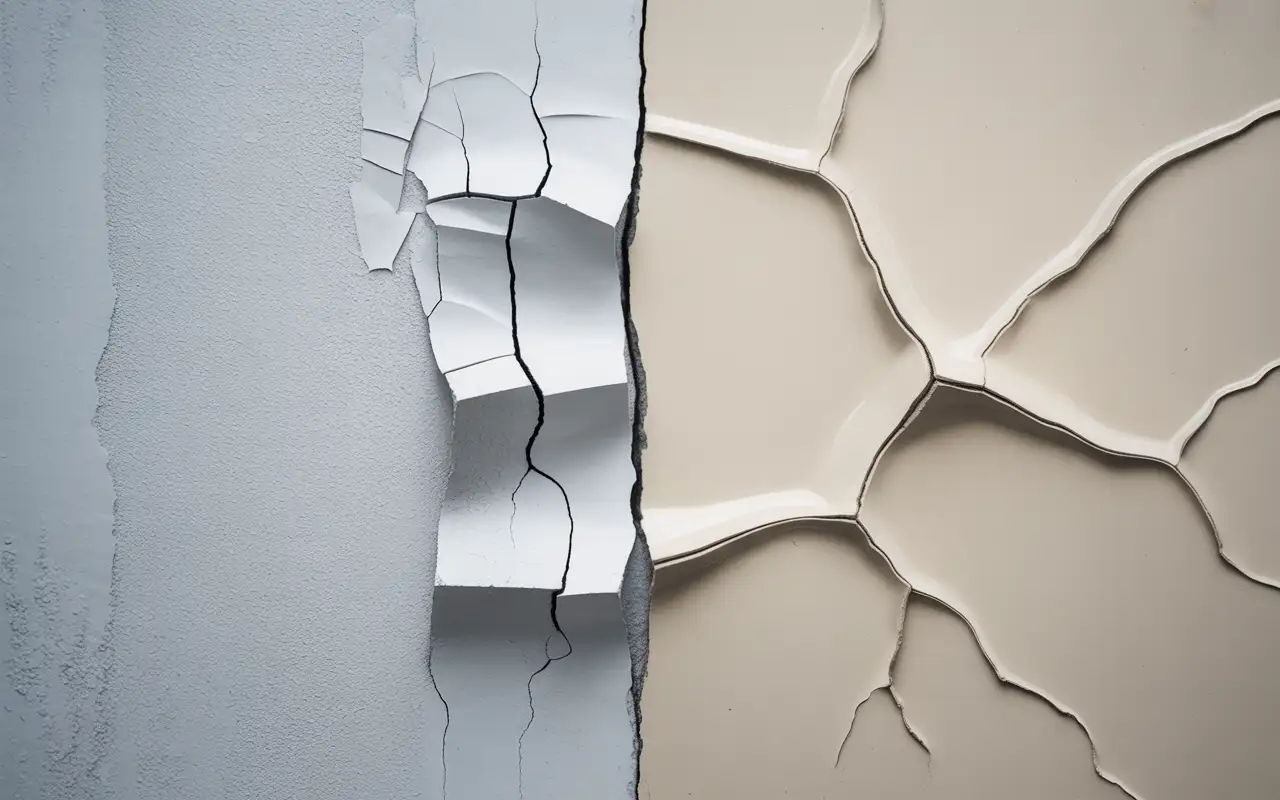Homeowners frequently ask: what is the best temperature for outdoor painting? Failure to get this right wastes both money and your paint job; most don’t realize that air temperature alone doesn’t determine success; surface temperature also plays a part.
Temperature is only one aspect of outdoor painting success; humidity, direct sunlight and time of day all play important roles as well. Latex paint works in temperatures as low as 35°F and oil-based needs at least 40°F to adhere properly. But temperature alone cannot guarantee quality coverage on siding panels humidity plays just as much of an influential role!
What Is the Best Outdoor Painting Temperature?

The best temperature for outdoor painting depends on your paint type. Latex paint performs well between 35°F and 90°F. Oil-based paint needs warmer conditions, working best from 40°F to 90°F.
Table of Contents
ToggleThe ideal temperature range sits between 50°F and 70°F for both types. At these temperatures, paint flows smoothly, dries evenly, and creates a strong bond with your surface.
Here’s why this range works:
Paint needs warmth to cure properly. When temperatures drop below 50°F, latex paint thickens and becomes harder to apply. Oil-based paint gets even stiffer, making brush strokes visible and reducing coverage.
Heat causes different problems. Above 85°F, paint dries too quickly. The surface forms a skin before the paint underneath cures. This creates bubbles, blisters, and early peeling.
Most paint cans list the manufacturer’s recommended temperature range on the label. Check this before you start. Some specialty paints work in temperatures as low as 35°F, but they cost more and need careful application.
Understanding Surface Temperature vs Air Temperature
Your weather app shows air temperature. But surface temperature matters more for painting quality.
Dark siding absorbs heat. A black or navy wall can reach 110°F when the air temperature is only 85°F. Light colors stay cooler but still run 10-15 degrees warmer than the air.
Use an infrared thermometer to check surface temperature before painting. Point it at your siding and read the display. If the surface exceeds 90°F, wait for cooler conditions or move to a shaded area.
Morning dew also affects surface temperature. Even when air temperature hits 60°F by 10 AM, north-facing walls might still be cold from overnight temperatures. These surfaces need time to warm up before they’re ready for paint.
Paint Type Comparison: Latex, Acrylic, and Oil-Based
Latex Paint works in the widest temperature range. It’s water-based, so cleanup is easy. Modern latex paints include acrylic resins that improve durability and weather resistance.
Latex handles temperatures ranging from 35°F to 90°F. Special low-temperature formulas contain coalescing agents that help paint cure in cold weather. Sherwin Williams Duration and Behr Premium Plus are popular choices for exterior projects.
Acrylic Paint is technically a type of latex paint but uses 100% acrylic resins. It costs more but lasts longer. Acrylic resists UV damage better than standard latex, making it perfect for south-facing walls that get constant sun exposure.
Temperature requirements match latex: 35°F to 90°F. Acrylic paint stays flexible in temperature extremes, reducing cracking as your siding expands and contracts.
Oil-Based Paint needs warmer conditions. Don’t use it below 40°F. The solvent-based formula thickens in cold weather, making application difficult.
Oil-based paint creates an extremely durable finish. It works well for trim, doors, and metal surfaces. However, it releases strong fumes and requires mineral spirits for cleanup. Most homeowners choose latex for large exterior projects.
Playing in Humidity Under 50%
Low-humidity paint conditions are critical for optimal paint performance. Climates with Humidity over 50% will add moisture to the air, which will inhibit the drying and curing process of the paint. This is especially true for water-based formulations.
Humidity requirements vary greatly by region. Coastal areas tend to have higher humidity levels than inland, and you have to be careful to time your paint job. You may get lucky in a desert climate with lower humidity levels, but face challenges due to extreme temperatures plus rapid evaporation.
How to Measure Temperature Correctly
The surface temperature can vary greatly from the air temperature, sometimes, 20-30 degrees, because of direct sunlight. Be sure to use an infrared thermometer and take the actual surface temperature before starting your exterior paint job.
Usually, the morning temperature is the most stable temperature to paint because the winds will not be blowing, and the surface hasn’t heated up from the sun yet. Painting outside in the afternoon can prove more difficult due to the above conditions.
Additional Temperature Factors to Take Into Account When Painting Outside

Time of Day Makes a Difference
Paint between 10 AM and 2 PM during cooler months. This window gives surfaces time to warm up after overnight cold.
In hot climates, reverse this schedule. Paint early morning or late afternoon when temperatures drop below 85°F. Follow the shade around your house. Start on the east side in the afternoon, then move to the west side as the sun shifts.
Never paint in direct sunlight during summer. The surface heats up too much, causing paint to dry and cure too quickly. This prevents proper adhesion and creates visible brush marks.
Regional Climate Considerations
Southern States (Texas, Florida, Arizona) face extreme heat. Early fall offers the best conditions, with temperatures between 70°F and 85°F. Avoid June through August when temperatures exceed 95°F regularly.
Choose UV-resistant paint for southern climates. Products like Sherwin Williams SuperPaint or Behr Marquee contain additives that prevent color fading and heat damage.
Midwest and Northern States (Chicago, Milwaukee, Detroit, Minneapolis) have short painting seasons. Late spring and early fall provide ideal temperatures. Summer works too, but watch for sudden temperature drops at night.
In these regions, paint must cure before the first freeze. Cold weather below 35°F can ruin fresh paint, even if it feels dry to the touch.
Coastal Areas deal with high humidity year-round. Temperature matters less than moisture control. Paint during low-tide hours when humidity drops slightly. Use mildew-resistant paint like Rust-Oleum Watertite or KILZ Masonry to prevent mold growth.
The 48-Hour Rule
Paint needs 24 to 48 hours to cure completely. Check your weather forecast for this entire period, not just painting day.
If temperatures will drop below 50°F within 48 hours, reschedule your project. Cold air slows the curing process. The paint might look dry but hasn’t formed a proper bond yet.
Rain within 48 hours also ruins fresh paint. The water-based formula stays vulnerable to moisture until fully cured. Even a light drizzle can cause streaking, spotting, or total paint failure.
Does Humidity Matter When Painting Outside?
Yes. Humidity affects paint quality as much as temperature does.
The ideal humidity range sits between 40% and 70%. Below 40%, paint dries too fast and may crack. Above 70%, paint stays wet longer and attracts dirt, insects, and pollen.
Problems Caused by High Humidity
- Extended Dry Times: Water vapor slows evaporation. Paint that normally dries in 4 hours might need 8 hours when humidity exceeds 80%. This delays second coats and extends your project timeline.
- Blistering and Bubbling: High humidity combined with direct sunlight heats the surface temperature rapidly. Water vapor gets trapped under the paint film, creating bubbles. Once these bubbles burst, they leave permanent marks.
- Leaching: Brown or white stains appear on freshly painted surfaces when humidity is too high. This happens because excess moisture pulls additives out of the paint before it cures. Leaching ruins the finish and reduces durability.
- Mildew Growth: Humid conditions create perfect breeding grounds for mold and mildew. The paint surface stays damp, allowing spores to grow. Black and green spots appear within weeks.
Use mildew-resistant paint in humid climates. Products containing antimicrobial additives prevent mold growth for years.
Humidity and Paint Type
Water-based latex paint struggles more with humidity than oil-based paint. The extra moisture in the air competes with the water in the paint, slowing the drying process.
Oil-based paint handles humidity better but releases stronger fumes in moist air. The smell lingers longer when humidity is high.
Check humidity levels with a hygrometer before painting. These devices cost $15-30 at hardware stores. If humidity exceeds 70%, wait for drier weather conditions.
How Temperature Affects Exterior House Painting Quality
Problems from Cold Weather Painting
Poor Adhesion: Paint needs warmth to bond with surfaces. Below 50°F, the chemical reaction that creates adhesion slows down. The paint sits on top of your siding instead of bonding to it.
Within months, you’ll see peeling and cracking. The paint job fails before the first year ends.
Longer Dry Times: Cold air holds less moisture, but paint still takes longer to dry. The formula thickens, staying wet for hours. This attracts dust, leaves, and insects that get stuck in the paint.
Reduced Coverage: Thick, cold paint doesn’t spread evenly. You’ll use more paint per square foot and still get an uneven finish. One gallon might cover 250 square feet instead of the rated 400 square feet.
Frosting Damage: If frost forms on fresh paint, it’s ruined. Ice crystals break the paint film before it cures. You’ll need to scrape everything off and start over.
Problems from Hot Weather Painting
Flash Drying: Paint dries too fast in temperatures above 90 degrees. The surface forms a skin while the paint underneath stays wet. This causes:
- Visible brush and roller marks
- Uneven color and sheen
- Poor adhesion to the surface
- Early paint failure
Blistering: Heat creates gas bubbles in the paint film. These blisters pop and leave permanent damage. You’ll need to sand, prime, and repaint affected areas.
Color Changes: Extreme heat affects pigment. Dark colors fade faster when applied in hot weather. The paint never reaches its true color because the formula breaks down during application.
The Solution: Proper Planning
Check 7-day weather forecasts before starting your painting job. Look for:
- Daytime temperatures between 50°F and 85°F
- Nighttime temperatures above 50°F
- Humidity between 40% and 70%
- No rain for 48 hours after painting
- Mild wind (light breeze is fine, but avoid windy days)
Don’t rush the project to meet a deadline. Waiting a week for better weather conditions saves thousands of dollars in premature paint failure.
Best Practices for Temperature-Challenged Painting Projects
Low-Temperature Painting Tips
If you must paint in cold weather, use these strategies:
- Choose specialty paint: Buy latex paint formulated for temperatures as low as 35°F. These products contain additives that help paint cure in cold conditions.
- Warm the surface: Store paint in a heated room before use. Never paint with cold paint straight from the garage.
- Apply thin coats: Multiple thin coats work better than one thick coat in cold weather. Each layer dries faster and bonds better.
- Use quality primer: Cold weather primer improves adhesion. Rust-Oleum Stops Rust Primer works well in temperatures down to 35°F.
High-Temperature Painting Tips
For hot weather painting:
- Paint in shade: Follow the sun’s shadow around your house. Paint areas as they move into shade.
- Wet the surface: Lightly mist the wall before painting. This cools the surface temperature by 10-15 degrees. Don’t soak it—just dampen it.
- Add paint conditioner: Products like Floetrol slow drying time in hot weather. This gives paint more time to level and bond properly.
- Work in sections: Paint small areas at a time. This prevents the paint from drying before you can smooth it out.
Regional Painting Calendar
- Northeast and Midwest: Best months are May, June, September, and early October. Avoid November through April.
- Southeast: Paint February through May and October through November. Skip June through September due to extreme heat and humidity.
- Southwest: October through April offers ideal conditions. Summer temperatures exceed safe painting limits.
- Pacific Northwest: May through September works well. Winter brings too much rain, even when temperatures stay mild.
- Mountain States: June through August only. Short painting season due to cold winters and late springs.
Call SD Custom Painting for Professional Exterior House Painting Services
Temperature timing isn’t the only factor in a successful paint job. Surface preparation, proper primer selection, and professional application techniques matter just as much.
San Diego Custom Painting brings 27+ years of experience to every project. We track weather forecasts daily and schedule work during optimal conditions. Our team understands how San Diego’s coastal climate affects paint performance.
We use premium products from Sherwin Williams, Behr, and Benjamin Moore. Each project gets a detailed surface inspection, proper preparation, and warranty-backed application.
Looking for reliable exterior painting services in San Diego? We offer free estimates and flexible scheduling. Our projects finish on time because we plan around the weather, not against it.
Contact us today to discuss your exterior painting project. We’ll evaluate your home, recommend the best products, and schedule work during ideal temperature conditions.
Conclusion
The best temperature for outdoor painting falls between 50°F and 85°F, but temperature alone doesn’t guarantee success. Surface temperature, humidity levels, time of day, and weather forecasts all play important roles.
Latex paint works in cooler conditions than oil-based paint, making it the better choice for most exterior projects. Modern formulas handle temperatures as low as 35°F with proper application techniques.
Plan your painting job around weather, not your schedule. Waiting for ideal conditions saves money and prevents premature paint failure. A quality paint job done in proper conditions lasts 10-15 years. A rushed job in poor conditions fails within 2-3 years.
FAQs About Cold Weather Painting
Can I paint my house exterior in winter?
Yes, but only when temperatures stay above 35°F for latex paint or 40°F for oil-based paint. You need 48 hours of suitable weather after painting. Winter painting works best between 10 AM and 2 PM when surface temperatures peak. Use low-temperature paint formulas and check surface temperature with an infrared thermometer. Most professionals avoid winter painting because weather windows are too short and unpredictable.
What happens if it gets cold after I paint?
If temperatures drop below 50°F within 24 hours of painting, the paint may not cure properly. You’ll see poor adhesion, early peeling, and reduced durability. If frost forms on fresh paint, the ice crystals damage the paint film permanently. The paint might look fine initially but will fail within months. Always check 48-hour forecasts before starting exterior painting projects.
What’s the lowest temperature for outdoor painting?
The minimum temp to paint outside is 35°F for specially formulated latex paint and 40°F for standard latex or oil-based paint. However, surface temperature matters more than air temperature. Even if the air reaches 35°F, north-facing walls might still be colder. Use an infrared thermometer to verify surface temperature before painting.
How does temperature affect paint drying?
Cold temperatures slow drying and curing. Paint might take twice as long to dry when temperatures drop to 50°F. Hot weather causes paint to dry too quickly, preventing proper leveling and adhesion. The ideal temperature range of 50°F to 70°F balances drying speed with curing quality. Paint applied in this range dries in 4-6 hours and cures completely within 24-48 hours.
Can I speed up paint drying in cold weather?
You can’t safely speed up drying in cold weather. Heat guns or space heaters create uneven drying that damages paint. The best approach is using low-temperature paint formulas and painting during the warmest part of the day. Apply thin coats that dry faster than thick coats. Each coat needs time to cure before applying the next one.
What temperature can you paint outside with oil-based paint?
Oil-based paint requires temperatures between 40°F and 90°F. It thickens significantly below 40°F, making application difficult. The formula needs warmth to flow properly and create a smooth finish. Oil-based paint also takes longer to dry than latex, requiring stable temperatures for 48-72 hours after application.
How warm does it have to be to paint outside?
It needs to be at least 50°F for reliable results with standard paint. While specialty formulas work at 35°F, 50°F provides better conditions for proper adhesion and curing. Surface temperature should match or exceed air temperature. Paint when conditions will remain stable for 48 hours after application.





